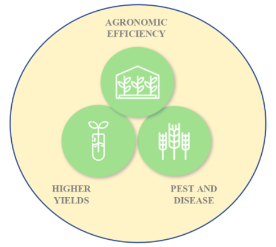Cymra Life Sciences chief operating officer Simon Pettinger argues cannabis companies need to think differently to jump the government’s regulatory hurdles and deliver cost-effective products to patients.
Car racing teams are always searching for incremental improvements to get a few milliseconds advantage, but once every few generations one team makes a dramatic change by thinking about solving a problem through a completely new lens. That’s how we at Cymra Life Sciences are thinking about cannabis.

Crops such as tomatoes, cucumbers and wheat have had hundreds of years of commercial development, while medicinal cannabis has had less than a decade and has been tightly controlled by government restrictions/legislation. It is essentially a new commercial crop.
Cymra’s head of breeding Matt Turner, who has more than 30 years of plant breeding experience, states: “Cannabis has been and continues to be restricted by governments around the world, hampering the speed of innovation around genetic improvement. The opportunity to make cannabis a more efficient and cost-effective crop to reduce costs for patients has huge worldwide potential.”
As one of the few worldwide companies focused on genetics, we set out to breed a plant that would make the agricultural efficiency of medicinal cannabis possible. Once this occurs at scale, patients will have affordable access to potentially beneficial medicines.
Of course, there will always be high-end segments of the cannabis industry who believe in premium indoor flower for smoking. However, we believe it is not sustainable for a patient who may have to pay more than $300 a month for their pain medication in Australia (we acknowledge that government regulation also plays a considerable part in the high patient costs).
Through innovative breeding we believe Australian cannabis cultivators can produce cheaper medicines and continue to operate in a high-cost country such as Australia. We set out to do this by focusing on plant agronomics, breeding new cannabis varieties with better input traits, that deliver agronomic efficiency gains, increased yields and resistance to pests and disease.

Agronomic efficiency
Agronomic efficiency means maximising the efficiency of the grower and the plant to reduce labour and overall costs where growing occurs in limited spaces, whether indoor, outdoor or greenhouse.
Plant breeding has gone hand in hand with the technological development of greenhouses and horticultural equipment – this is evident in crops such as tomatoes and cucumbers. Growing a tomato plant at home in your garden is a very different experience to growing one inside a greenhouse and we believe the same should be said of commercial cannabis.
To reduce costs for patients the cannabis plant needs to be grown more efficiently when compared to how a hobbyist would grow it at home.
Higher yields
We focus on creating a ‘sea of green’ through breeding a new agronomic form versus intensive plant training and trimming. This new form will have less branching and a longer internode length. The new sea of green created through individual plants will ultimately lead to more primary buds per square metre than current practices.
Whether a cultivator is indoor, outdoor or greenhouse, their space is limited and maximum yield is critical as the supply of cannabis increases around the world.
As found by Namdar et al in their 2018 study “the amounts of cannabinoids and terpenoids in the inflorescences decreased with the position of the sampled inflorescence from top to bottom of the flowering stem”.

In fact, their results showed that upper stem flowers produced up to 40% more than mid flowers and 80% more than lower-stem flowers.
Through focusing on breeding plants that only produce a single primary flower that can be planted close together, we believe there will be a dramatic increase in yield for cultivators.
Pest and disease
This new agronomic form will promote airflow around the bud, reducing mould risk, but importantly those plants will promote air flow through the canopy and reduce bugs and diseases spreading through direct contact.
Turner states: “The novel form enables many production possibilities that are not available for typical cannabis types, and consequently we are optimising our production strategy to further reduce the likelihood of pest and disease outbreaks.”
The new agronomic form also has the added benefit of little to no trimming of leaves and stems required to make a sea of green. This means there will be a reduction in wound points on the plant which decrease disease vectors into the plant and ultimately reduce the risks of disease.
What does this mean for cultivators?
Based on our research, current cannabis production methods typically have 5-6 plants per square meter with six primary buds and up to five secondary buds per plant. Our new approach could see up to 20-30 plants per square meter and therefore 20-30 primary buds per square meter.
“The opportunity to make cannabis a more efficient and cost-effective crop to reduce costs for patients has huge worldwide potential.”
We estimate this could see a yield increase of 57% per square metre per turn, with up to a 73% saving in labour. Turner states: “We are breeding plants that will fit into a novel production system, which will increase cannabinoid yields per square metre. When developing the production system, the early prototypes of this form showed promising yield potential.”
Cymra is currently working on delivering improved localised hybrids that have been through an intensive testing and quality assurance process, providing comprehensive data and trial results to help cultivators make the decision about which variety is best suited to their conditions.
What does this mean for patients?
If cultivators can improve their yield per square meter and reduce labour costs, the overall costs of supply of cannabis pharmaceutical ingredients will come down dramatically.
It’s important to understand that initially this will be more for pharmaceutical formats, but as the science and agronomic trials evolve, it could affect the whole market. Agronomic efficiencies take a long time to develop through conventional breeding programs, where a cannabis plant takes ~ 10 weeks to seed and reproduce.
- With exclusive genetics and tissue culture services, Cymra helps cannabis cultivators increase productivity and reduce risk. The company has a team of plant breeders, plant scientists and agricultural experts that are focused on helping cultivators succeed. Cymra is focused on partnering with Australian cultivators to develop and deliver unique genetics suited to their agronomic and eventual final product formulation for their environment.

